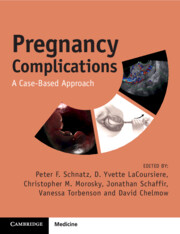Book contents
- Pregnancy Complications
- Pregnancy Complications
- Copyright page
- Contents
- Contributors
- Preface
- Note from the Editor-in-Chief
- Normal Laboratory Values (Conventional Units) []
- Section 1 Antepartum (Early Pregnancy)
- Case 1 A Patient of Ashkenazi Jewish Ancestry Presents for Preconception Counseling
- Case 2 A Patient with a Subchorionic Hematoma Presents with Early Vaginal Bleeding
- Case 3 A 25-Year-Old with a Twin Gestation at 9 Weeks
- Case 4 A 35-Year-Old with HSIL Cervical Cytology at 10 Weeks
- Case 5 A 20-Year-Old with a Molar Pregnancy at 8 Weeks
- Case 6 A 20-Year-Old with Anxiety and Depression at 7 Weeks
- Case 7 A 40-Year-Old with Nausea, Vomiting, and Weight Loss at 7 Weeks
- Case 8 A 30-Year-Old with Worsening Migraine Headaches at 14 Weeks
- Case 9 A 30-Year-Old with Isoimmunization at 9 Weeks
- Case 10 A 25-Year-Old with an Early Pregnancy and Bicornuate Uterus
- Case 11 Recommended Vaccinations at an 8-Week Prenatal Intake
- Section 2 Antepartum (Mid-trimester)
- Section 3 Antepartum (Late Pregnancy)
- Section 4 Antepartum (Medical Complications)
- Section 5 Antepartum (Infectious Complications)
- Section 6 Intrapartum/Delivery
- Section 7 Postpartum
- Section 8 Fetal Complications
- Section 9 Placental Complications
- Section 10 Complications of the Cord, Amnion, and Gravid Uterus
- Section 11 Psychosocial Considerations
- Index
- References
Case 4 - A 35-Year-Old with HSIL Cervical Cytology at 10 Weeks
from Section 1 - Antepartum (Early Pregnancy)
Published online by Cambridge University Press: 08 April 2025
- Pregnancy Complications
- Pregnancy Complications
- Copyright page
- Contents
- Contributors
- Preface
- Note from the Editor-in-Chief
- Normal Laboratory Values (Conventional Units) []
- Section 1 Antepartum (Early Pregnancy)
- Case 1 A Patient of Ashkenazi Jewish Ancestry Presents for Preconception Counseling
- Case 2 A Patient with a Subchorionic Hematoma Presents with Early Vaginal Bleeding
- Case 3 A 25-Year-Old with a Twin Gestation at 9 Weeks
- Case 4 A 35-Year-Old with HSIL Cervical Cytology at 10 Weeks
- Case 5 A 20-Year-Old with a Molar Pregnancy at 8 Weeks
- Case 6 A 20-Year-Old with Anxiety and Depression at 7 Weeks
- Case 7 A 40-Year-Old with Nausea, Vomiting, and Weight Loss at 7 Weeks
- Case 8 A 30-Year-Old with Worsening Migraine Headaches at 14 Weeks
- Case 9 A 30-Year-Old with Isoimmunization at 9 Weeks
- Case 10 A 25-Year-Old with an Early Pregnancy and Bicornuate Uterus
- Case 11 Recommended Vaccinations at an 8-Week Prenatal Intake
- Section 2 Antepartum (Mid-trimester)
- Section 3 Antepartum (Late Pregnancy)
- Section 4 Antepartum (Medical Complications)
- Section 5 Antepartum (Infectious Complications)
- Section 6 Intrapartum/Delivery
- Section 7 Postpartum
- Section 8 Fetal Complications
- Section 9 Placental Complications
- Section 10 Complications of the Cord, Amnion, and Gravid Uterus
- Section 11 Psychosocial Considerations
- Index
- References
Summary
The management of cervical dysplasia in pregnant individuals focuses on maintaining maternal well-being while considering pregnancy-related factors. Risk-based colposcopy should be performed with an immediate CIN 3+ risk threshold of ≥4% or with other significant high-risk screening results. Testing for HPV is recommended for individuals aged 30 years and older and for postpartum surveillance of abnormal cases in those aged 25 years and older. The impact of financial support on postpartum medical care can influence the necessity of colposcopy during pregnancy. It is important to note that there are specific challenges with performing colposcopy during pregnancy and there needs to be judicious use of ectocervical biopsy. Excisional procedures are reserved for confirmed or likely invasive disease. In cases of cervical cancer, the involvement of specialized medical practitioners is advised. Postpartum management strategies involving colposcopy and expedited loop electrosurgical excision procedures underscore the significance of risk-based evaluations. In summary, the case provides comprehensive insights into managing cervical dysplasia during and after pregnancy, focusing on evidence-based guidelines and multidisciplinary collaboration for optimal outcomes.
Keywords
- Type
- Chapter
- Information
- Pregnancy ComplicationsA Case-Based Approach, pp. 10 - 12Publisher: Cambridge University PressPrint publication year: 2025

